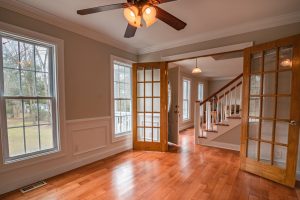The warm glow of hardwood floors adds undeniable charm and value to any Colorado home. But years of wear and tear can leave them looking worse for wear, presenting the homeowner with a crucial decision: floor repair or replace? Fear not, fellow Coloradans! We’ll equip you with the knowledge to navigate this flooring quandary and make the right choice for your wallet and your home.
Assessing Damage Severity: Factors Influencing Floor Repair or Replacement

Explore the choice between floor repair and replacement for maintaining the beauty of your hardwood floors
Before diving into costs, let’s delve into the telltale signs that indicate floor repair or replacement:
Repair-worthy woes:
- Minor scratches, dents, or scuffs: These are superficial blemishes addressed through sanding and refinishing, breathing new life into your existing floor.
- Loose boards or planks: These can often be re-secured or replaced individually, offering a cost-effective solution.
- Water damage affecting small areas: If the damage is contained and hasn’t warped the wood excessively, targeted repairs might be feasible.
Replacement red flags:
- Extensive water damage: Widespread warping, buckling, or mold growth necessitates complete floor replacement to ensure structural integrity and prevent further issues.
- Deep scratches, gouges, or cracks: When the damage penetrates deep into the wood, repairs may be impractical and aesthetically unpleasing.
- Multiple loose or damaged boards: Replacing individual boards becomes cost-prohibitive when dealing with widespread issues.
- Thinned wood due to excessive sanding: If previous refinishing has depleted the wood’s thickness, further sanding is impossible, necessitating replacement.
- The desire for a complete aesthetic overhaul: If you crave a dramatic change in style or species, replacing the entire floor offers the most flexibility.
Cost Considerations: Calculating the Financial Implications of Each Option
Now, let’s crunch some numbers:
Repair:
- Pros: Generally less expensive than replacement.
- Cons: Costs can vary depending on the extent of damage and materials needed. It may not be suitable for all types of damage.
Replacement:
- Pros: Offers a fresh start and increased lifespan.
- Cons: Significantly higher upfront cost, including material, labor, and potential removal of existing flooring.
Additional cost factors:
- Material selection: Hardwood species and quality significantly impact price.
- Labor costs: Hourly rates and project complexity influence the final bill.
- Permits and inspections: Required in some areas, adding to the overall cost.
Take note that while repair might seem like the cheaper option initially, extensive repairs can approach replacement costs. Consider the long-term value and potential resale impact when making your decision.
Invest in the long-term beauty and functionality of your floors. Contact T&G Flooring, your trusted experts in Colorado floor repair and replacement. Our experienced team can accurately assess the damage, provide transparent cost estimates for both repair and replacement, and guide you toward the most suitable solution for your budget and needs. Don’t let damaged floors dim your home’s shine – schedule a consultation with T&G Flooring today and restore your floors to their stunning best!

